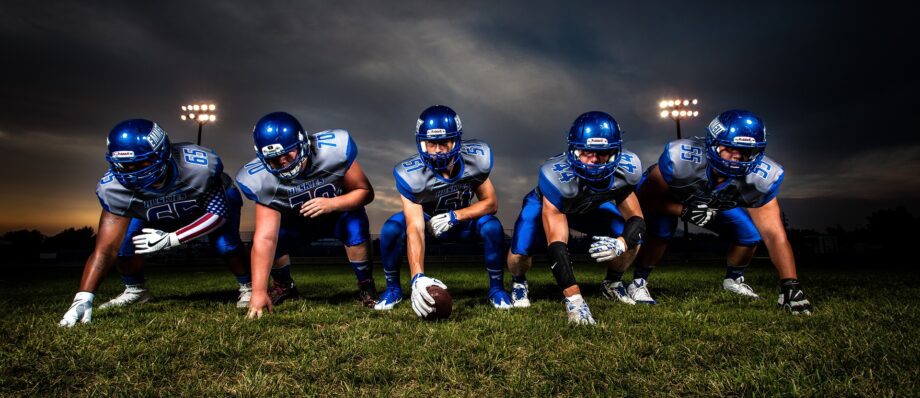Offensive and Defensive Lineman Training
- 01/12/2025
- College Recruiting
- 4 mins read
Table of Contents
ToggleThe Game Starts in the Trenches: The Vital Role of Offensive and Defensive Lineman
In football, the line (OL) and (DL) or offensive and defensive lineman aren’t just part of the game—they are the game. These positions define the tone, control the line of scrimmage, and often determine whether a team dominates or falls short. Without strong linemen, even the most talented quarterbacks, running backs, and receivers struggle to shine.
Dynamics of a Strong Offensive and Defensive Lineman
The offensive line’s role is to protect the quarterback and create running lanes for the backs. A synchronized, disciplined offensive line can transform a team into a scoring powerhouse, keeping defenses on their heels. Conversely, the defensive line exists to disrupt this rhythm. A strong defensive front shuts down the run, collapses pockets, and forces offenses into mistakes.
Both lines operate in the trenches, a place of raw strength and finesse where split-second decisions and movements can make or break a play. Success begins with mastering this dynamic.
Elite Offensive and Defensive Lineman
Elite linemen possess a rare combination of size, strength, technique, and mental toughness. Here’s what it takes:
- Physical Dominance: Strength, agility, and quickness are essential for winning battles in the trenches.
- Technical Precision: Hand placement, footwork, and leverage are critical for gaining an advantage.
- Football IQ: Reading plays, understanding schemes, and reacting quickly separate good linemen from great ones.
- Relentless Effort: Coaches value players who show grit and never take a play off.
Drills That Build Dominance
Coaches use a variety of drills to sharpen their linemen’s skills:
- Sled Work: Pushing and pulling sleds builds explosive power, simulates blocking, and reinforces driving through the defender.
- Hand Fighting Drills: Linemen practice rapid hand placement and disengagement techniques to win battles at the point of attack.
- Mirror Drills: These improve lateral movement and footwork, helping linemen stay in front of their assignment or evade blockers.
- One-on-One Pass Rush Drills: These simulate game situations, teaching both offensive and defensive linemen to adapt to an opponent’s moves in real time.
- Leverage Drills: Focused on staying low and driving through contact, these drills emphasize balance and power.
Alternative Training Methods
Elite linemen often go beyond traditional football drills to gain an edge:
- Boxing: Boxing builds hand speed, coordination, and stamina. It also enhances mental toughness, teaching athletes how to stay focused under pressure.
- CrossFit: High-intensity CrossFit workouts improve overall strength, explosiveness, and endurance, helping linemen perform consistently through the fourth quarter.
- Yoga: Flexibility and balance are critical for linemen, and yoga can prevent injuries while improving range of motion and body control.
- Strongman Training: Exercises like tire flips, farmers carries, and sled drags mimic the physical demands of playing on the line.
The Mental Side of Being an Strong Offensive and Defensive Lineman
Success in the trenches is as much mental as it is physical. Linemen need to approach each play with focus, determination, and confidence. Here are key aspects of the mental game:
- Resilience: Linemen face constant battles. Learning to bounce back from a bad play or loss is critical.
- Quick Decision-Making: Offensive and defensive linemen must react to the snap and read their opponents’ intentions in an instant.
- Patience and Discipline: It’s easy to lose composure in the trenches, but staying calm and executing the game plan separates the best from the rest.
- Team Mentality: Linemen must trust and work seamlessly with their unit. A great line operates as one cohesive force.
Teaching Methods for Offensive and Defensive Lineman
Coaches use a variety of techniques to develop offensive and defensive linemen:
- Drills for Fundamentals: Practices often include sled pushes, one-on-one pass-rushing drills, and mirror drills to sharpen technique.
- Film Study: Reviewing game tape helps players understand their strengths and weaknesses while preparing for opponents.
- Live Situations: Coaches simulate game scenarios to improve decision-making and execution under pressure.
- Strength and Conditioning: Targeted workouts build power, endurance, and flexibility.
What College Coaches Look For
When college coaches scout Offensive and Defensive Lineman, they’re looking for more than size and strength. They want athletes who demonstrate:
- Physical Traits: Coaches prioritize height, weight, arm length, and overall build for offensive and defensive linemen.
- Athleticism: Quickness, agility, and balance are critical, especially for linemen competing at the college level.
- Consistency: Linemen who perform at a high level play after play catch the eye of recruiters.
- Work Ethic and Coachability: Being willing to learn and improve is essential for college success.
Take Action and Dominate the Trenches
If you want to stand out as an elite Offensive and Defensive Lineman, start by mastering the fundamentals. Commit to relentless training, embrace alternative methods to improve your game, and focus on building mental resilience.
The trenches are where games are won, and linemen are the unsung heroes of every team. But to move from good to great, you must take action. Challenge yourself to go beyond what’s expected. Work harder, train smarter, and dedicate yourself to becoming the kind of Offensive and Defensive Lineman every coach wants on their team.
Your journey starts now. Push the sled. Watch the film. Hone your craft. Every rep you take today brings you one step closer to dominating the line tomorrow. The question is—are you ready to take your place among the best? If yes, click the button below



